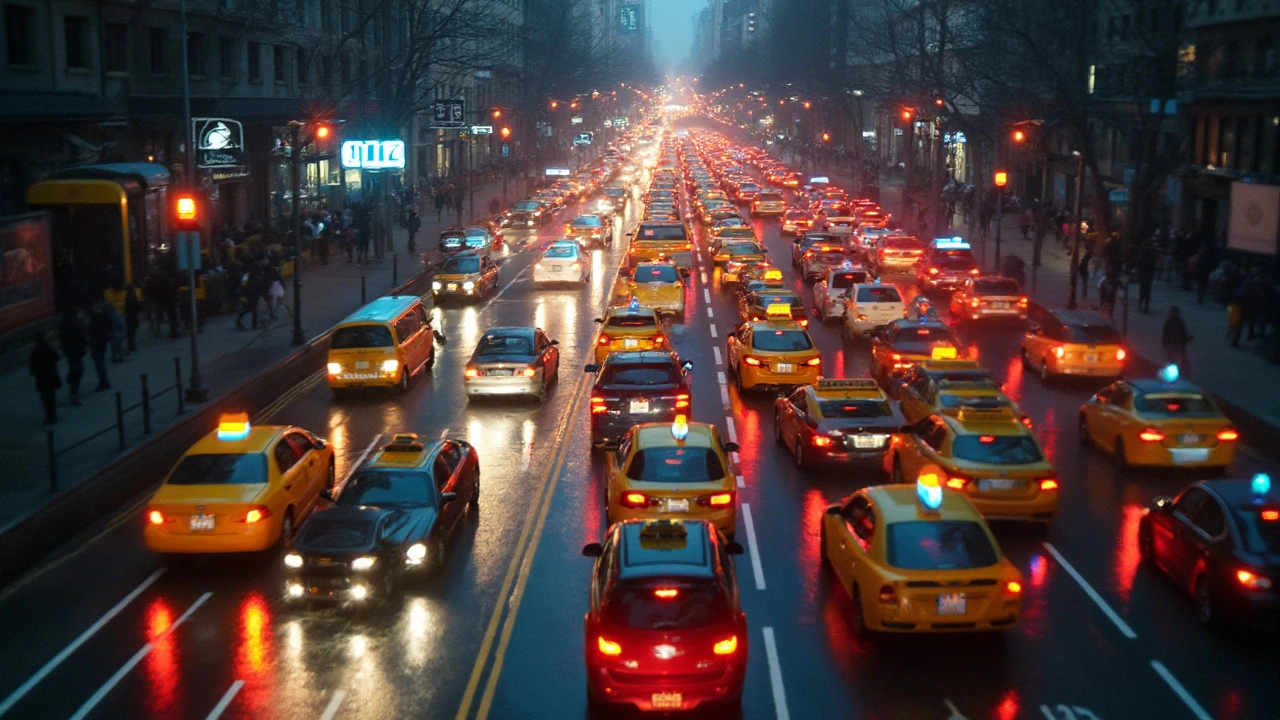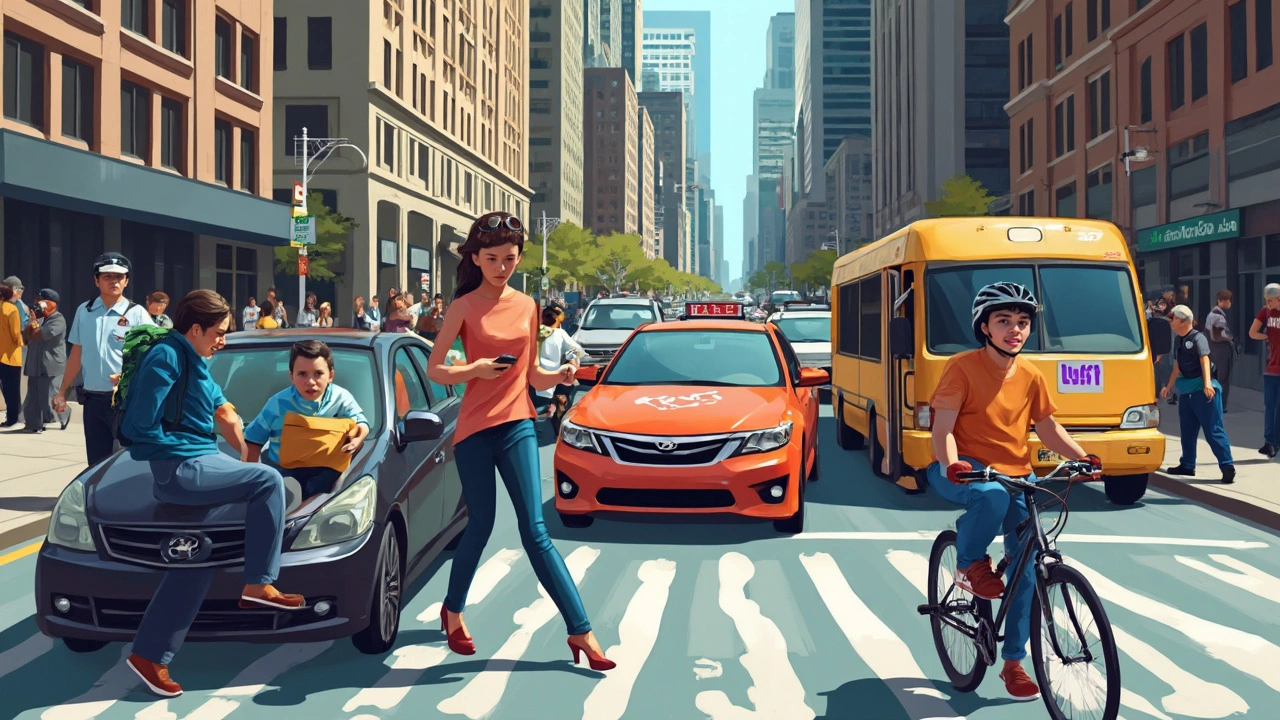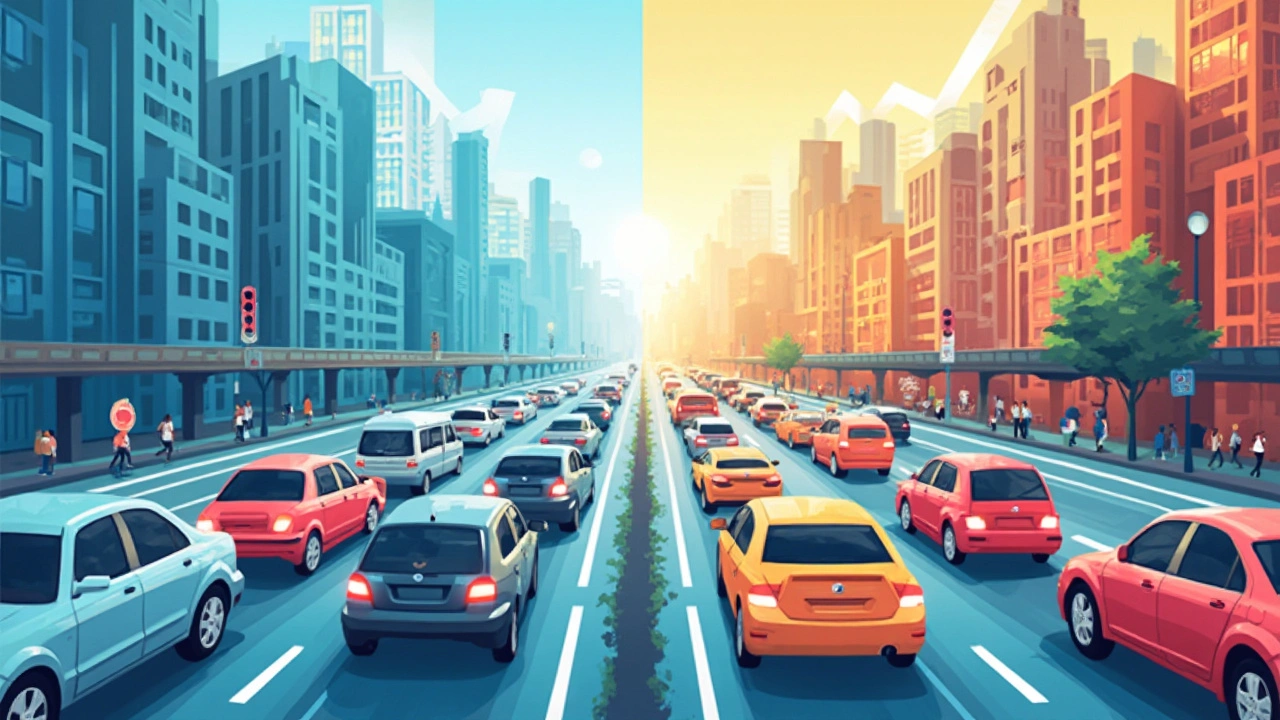How Ride-Sharing Apps Affect City Traffic and Urban Congestion
 Jun, 5 2025
Jun, 5 2025
Picture this: You open your phone, tap a few buttons, and in five minutes a car arrives outside. Sounds convenient, right? That’s today’s world thanks to ride-sharing apps like Uber and Lyft. You probably use these services to dodge the headaches of parking and public buses that seem allergic to being on time. But as millions of riders jump in, city streets are overflowing with cars wearing the signature Uber or Lyft sticker. Take New York, for example. In 2024, there were 100,000 active ride-hail vehicles zipping around Manhattan, almost double the number from a decade ago. Many cities have seen a similar spike. The real question everyone asks is whether these cars clear congestion or double down on traffic jams. It’s not as clear cut as you might think.
How Ride-Sharing Jammed Up Urban Streets
When Uber first hit the streets back in 2011, it looked like a magic bullet for traffic. Most thought it would pull people out of their private cars, slash fuel use, and fill empty seats. Turns out, things didn’t pan out so simply. A 2022 Boston study found that 60% of Uber and Lyft rides would not have happened at all or would have used mass transit if the apps didn't exist. That means instead of sharing, these cars created trips that wouldn’t have happened—or would have taken a subway instead.
Cities like San Francisco and Chicago saw vehicle miles traveled (VMT) shoot up 10% just after ride-sharing took hold. A table from a 2023 MIT urban transport research captured it best:
| City | Year Uber/Lyft Introduced | Increase in Vehicle Miles Traveled (VMT) |
|---|---|---|
| New York | 2011 | 8.3% |
| San Francisco | 2012 | 12.5% |
| Chicago | 2013 | 9.8% |
Why? Ride-hail drivers cruise for fares between rides—industry insiders call this “deadheading.” Studies have revealed that over 40% of ride-share miles are driven without a paying passenger. Add to this the people who would otherwise walk, bike, or hop on a bus but are now summoning a car even for short distances. The simple truth: more cars are on the street, and cities are feeling the squeeze.
The Double-Edged Sword: Convenience Versus Congestion
There’s no question these apps have changed life for the better for many folks. Think about late-night workers, people in transit deserts, or anyone who hates the hassle of car ownership. In Atlanta’s suburbs, where buses don’t run late, Uber has been a lifeline—so much so that job access for shift workers rose 15% in areas covered by ride-sharing in 2023.
Still, the price is congestion—especially at busy times and places. Data from Los Angeles last year showed that 25% of cars circling the main airport terminals were ride-shares. A similar story happened in San Francisco’s downtown, where peak-hour travel times increased by 21% after ride-hail activity exploded downtown.
Extra traffic brings other headaches, too: slower emergency vehicles, tougher parking, and dirtier air. The American Lung Association pointed to ride-sharing’s impact when it ranked metro areas for smog. Congestion, pollution, and noise—apps didn’t create these city woes, but they sure didn’t cure them either.
It begs a simple question. Are the benefits of easy point-to-point trips worth the extra cars and the grind of rush hour?

Are Ride-Sharing Services Helping Anyone Beat the Traffic?
The short answer: yes—but not for everyone equally. Ride-sharing is a lifeline in neighborhoods where transit is nonexistent or unreliable. Take Detroit, where more than 30% of the population lacked a car in 2024. Instead of missing jobs or appointments, people grabbed an app and found a better way to get around. In Miami, Uber and Lyft started reaching into neighborhoods called “transit deserts,” and job opportunities for residents jumped by 18%.
But here’s a curveball: in cities with good trains, buses, or even bike lanes, ride-sharing often pulls people off those greener options. Washington, D.C. Metro saw a 5% drop in passenger numbers as Uber and Lyft gained ground. Most of these riders weren’t switching from personal cars; they just swapped the train for a ride-hail car. It’s called “mode substitution”—and in cities hoping to cut traffic, it’s not good news.
Still, the apps have sparked creative ideas. Some places have encouraged “pooled” rides—think UberPOOL or Lyft Shared, where strangers heading the same direction split a ride. When these programs work, they reduce single-passenger trips and pull excess cars off the road. But they only succeed if lots of people use them at once, and let’s be honest—most folks prefer the backseat to themselves.
Smart Solutions: Could Apps Ease Traffic—If We Use Them Right?
Tech itself isn’t good or bad—it’s all in how we use it. Imagine cities using ride-sharing apps as part of a bigger, smarter plan. For starters, several places have started charging ride-shares extra fees to pick up passengers in traffic-clogged areas. Manhattan’s “congestion pricing” plan, rolling out later this year, will slap a hefty toll on Uber and Lyft cars traveling below 60th Street during peak hours. The hope? Fewer rides downtown, more on mass transit.
Even app-makers have started tweaking how their services work. Uber and Lyft now promote carpool trips right in their apps and have even teamed up with city bus lines to link people with both shared rides and public transit. In Seattle, anyone calling for Uber Shuttle during rush hour finds the app suggesting fast public buses or linking up groups heading the same way. Drivers also get smarter routing tips to avoid deadheading and cut down on pointless cruising.
If cities really want apps to help, they need good transit, protected bike lanes, and better curb management—zones just for drop-offs and pick-ups so traffic doesn’t back up mid-block.
- If you’re a regular eyeing ways to beat the gridlock, try pooled rides—even if it means sharing your playlist with a stranger.
- Use ride-shares to connect with transit for the “last mile,” not to escape public buses altogether.
- Check if your company offers ride credits for using eco-friendly shared ride options.
- Skip the curb drama: agree on pick-up spots away from the busiest corners.
Apps have the tools to ease the crunch, but success depends on both people and policymakers making it happen.

The Road Ahead: Ride-Sharing in Tomorrow's Cities
It’s wild to imagine that just a dozen years ago, grabbing a ride meant hailing a yellow cab or booking a town car. Now, with a couple taps, we summon trips for everything from a coffee run to the airport, all while tracking the driver’s location. So what’s next? Urban planners have big ideas—and some challenges.
Data will drive the future. More cities are demanding anonymized info from apps, so they can spot traffic patterns and tweak traffic lights or bus schedules. Boston and Toronto have started publishing real-time congestion maps that help both ride-hail drivers and city officials avoid the worst jams. New York’s plan to reroute traffic based on live ride-sharing activity will be one of the world’s first—if it works, expect other cities to copy it fast.
The arrival of electric and autonomous ride-sharing vehicles could flip the script in coming years. Electric Ubers already make up 20% of San Francisco’s fleet, cutting emissions as they go. Self-driving cars, still in pilot testing, might drive smarter routes, snagging the least-clogged streets and promising smoother, safer city travel. Who knows? Maybe in a few years, ride-sharing will help cities tackle congestion from the inside out instead of making it worse.
Until then, the impact of ride-sharing on city traffic remains a mixed bag. It helps many folks, especially outside walking distance of a subway or bus. But when everyone piles into private cars, the streets slow to a crawl. If you care about city life, traffic jams, and cleaner air, keep an eye on how these apps are used—as a problem or as part of the solution. The next time you tap ‘request ride,’ think about where your trip fits in. Will you keep the city moving, or add one more car to the packed parade?
Badal Patel
July 18, 2025 AT 19:33Honestly, the whole narrative that ride-sharing apps are the savior of urban traffic seems quite exaggerated if you ask me!!! While they do offer convenience, the impact on congestion is much more complicated.
There's data pointing to increased vehicle miles traveled because of these platforms. More cars cruising around waiting for rides or getting to passengers can end up being more harmful than beneficial! Have we really thought this through thoroughly???
What about the regulatory aspect? Cities not imposing strict controls are probably just letting the problem grow unchecked!!! To summarize, these apps might be just adding more vehicles on the road, hence making urban gridlock worse, ironically.
KIRAN nadarla
July 19, 2025 AT 06:40Glad someone mentioned the data angle!! So many folks love to romanticize ride-sharing without actual evidence. Let's be clear: the increase in traffic congestion in multiple cities correlates directly with the rise of Uber and Lyft. It's not a coincidence!!!
Also, the article's writing style could use improvement, lots of vague phrases like "creative tips" and "real insight" without quantifiable measures, come on! If we're discussing urban transportation, facts and figures should dominate.
And yes, grammar matters too in making arguments credible. Seriously, how can we trust conclusions when the writing lacks precision???
Kara Guilbert
July 19, 2025 AT 15:00Ugh, I can't stress this enough: ride-sharing companies have a massive responsibility in shaping our urban future. To be honest, their business model, prioritizing profit over sustainability, is problematic.
From what I’ve seen, instead of reducing our carbon footprint, they often worsen pollution levels by increasing the number of idle vehicles and encouraging people to abandon public transit.
On the bright side, individuals who choose carpool options do contribute positively, but those are sadly in the minority.
We need policies that really push for shared rides and penalize constant solo rides. Sharing is caring, right??
Sonia Michelle
July 19, 2025 AT 23:20I appreciate this discussion because it's far from black and white. Ride-sharing apps do offer undeniable convenience, especially for those who don't own cars.
But with convenience comes unintended consequences like increased congestion, as some have pointed out. What we need is a more integrated approach—bringing together ride-sharing with robust public transit.
In my city, combining both has helped ease the burden somewhat. Still, better urban planning and investing in truly sustainable options remain critical.
Ultimately, no single solution will solve urban congestion alone, and constructive collaboration is key.
Neil Collette
July 20, 2025 AT 02:06Oh great, another 'impact of ride-sharing' article, as if the world hasn't heard this tired debate already. LOL.
Let me tell ya, Uber and Lyft are just glorified taxi services with fancier apps. They don't magically unclog traffic at all. All the data screams 'more cars on the roads!' But people are too busy waving their phones to care.
Honestly, if cities wanted to fix congestion, they'd outlaw ride-share cruising. Instead, they let these companies flood streets with cars playing musical chairs. Ah, capitalism in action, quenching profits but drowning our city streets in chaos.
James Lee
July 20, 2025 AT 10:26Well, the whole situation reminds me of a paradox in transportation economics. Ride-sharing offers individual utility but often externalizes costs onto urban infrastructure.
This results in more miles driven and increased congestion—a typical tragedy of commons scenario.
Regrettably, city planners are still playing catch-up. Modern urban challenges demand holistic, interdisciplinary solutions rather than quick tech band-aids.
Yet, there lies hope in intelligent regulation and incentives focused on shared rides and electric vehicles.
It's not about demonizing ride-sharing but integrating it thoughtfully.
Dennis Scholing
July 22, 2025 AT 18:00This article provides a valuable overview of the complex relationship between ride-sharing services and urban congestion. It rightly acknowledges that the impact isn't straightforward and can vary by city and policy environment.
Transport planners should consider these nuances carefully to optimize mobility and environmental benefits. Collaborative governance models can help incorporate ride-sharing effectively into broader transportation networks.
In summary, embracing innovation while ensuring sustainability requires ongoing evaluation and adjustment.
Kasey Lauren
July 23, 2025 AT 21:46I think it’s super important to recognize that ride-sharing apps have helped a lot of people who don’t have cars or who live in places where public transit isn’t great.
Sure, there’s more traffic sometimes, but for a lot of folks, they make getting around easier and safer.
Maybe the real fix is just making those apps work better with public transit so nobody ends up stuck in traffic all day.
We can do that if cities and companies work together more.
Abhimanyu Singh Rathore
July 25, 2025 AT 01:33Well, while many have stressed the problems, a critical aspect lies in looking at statistical evidence and urban context!!!!
One cannot simply blame ride-sharing for congestion—urban growth patterns, road capacity, and transit availability play their roles too!!!
I also think the rise of these apps has forced cities to rethink policy and even broaden discussions about micromobility and sustainable options!!!
So, are these apps perfect? No. But their impact is nuanced and multifaceted, deserving careful formal analysis!!!
Stephen Lewis
July 26, 2025 AT 05:20This discourse highlights the intricate dynamics faced by urban planners in an increasingly digitized transportation ecosystem.
It is imperative that decision-makers employ an evidence-based approach to assess the externalities of ride-sharing platforms.
Effective integration with public transit, alongside regulatory frameworks promoting carpooling and low-emission vehicles, could mitigate negative consequences.
Ultimately, the goal remains a flexible, inclusive, and sustainable urban mobility framework.
Lynn Kline
July 27, 2025 AT 09:06I gotta say, I’m pretty hopeful about the future because ride-sharing has the potential to reduce the number of cars if used the right way!!!
What really matters to me is encouraging folks to share rides more often and that companies incentivize this behavior.
Of course, public transit needs to come along too, but I think these apps can fill gaps especially for first and last mile transit.
Let’s not forget the environmental benefits if more electric vehicles get on board as well!!!
With innovation, we can break free from congestion blues.